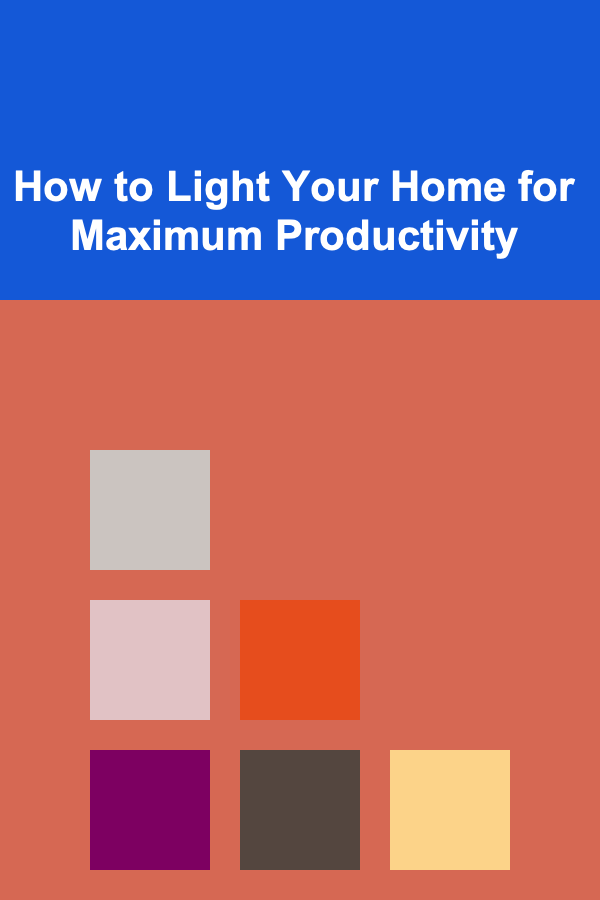
How to Light Your Home for Maximum Productivity
ebook include PDF & Audio bundle (Micro Guide)
$12.99$10.99
Limited Time Offer! Order within the next:

Lighting is an often overlooked but critically important factor in creating a productive environment at home. It influences not only how well you can focus but also how comfortable and motivated you feel throughout the day. Whether you're working from home, studying for exams, or simply trying to stay productive in a personal project, the quality of lighting in your space plays a central role in shaping your mental state and physical well-being. The right lighting can boost concentration, reduce fatigue, and improve overall productivity.
In this article, we will delve into the science behind lighting and its impact on productivity, explore the different types of lighting that can enhance focus, and provide practical tips for how to use lighting effectively in your home for maximum productivity.
The Science of Lighting and Its Impact on Productivity
Lighting has a significant effect on our mood, energy levels, and ability to concentrate. Research in the fields of psychology and environmental science has shown that lighting affects not only our circadian rhythms (the internal clocks that regulate our sleep-wake cycles) but also our cognitive performance. Proper lighting can improve alertness, focus, and memory retention, while poor lighting can lead to distractions, fatigue, and even headaches.
Circadian Rhythms and Their Role in Productivity
Our bodies are wired to respond to natural light. The circadian rhythm is influenced by external factors like sunlight, which helps regulate our sleep-wake cycles, alertness, and cognitive functions. Bright light in the morning helps signal to our brains that it's time to be awake and active, while dimmer light in the evening signals that it's time to wind down and rest.
When you're working or studying at home, it's important to align your lighting with your natural circadian rhythms to maximize energy and focus. Bright, blue-toned light during the day can help you stay alert and focused, while warm, dim lighting in the evening can help signal relaxation and rest.
The Psychological and Physiological Effects of Light
Lighting affects both our physical and psychological states. Bright lighting can help boost your mood and energy levels, while dim or soft lighting can create a relaxing atmosphere. However, exposure to the wrong kind of lighting at the wrong time of day can have negative effects:
- Bright Lighting: Cool, bright light is often associated with increased energy levels, which is why it's ideal for workspaces or areas where focus is required. It has been shown to enhance cognitive performance and reduce feelings of tiredness.
- Soft, Warm Lighting: On the other hand, warm, softer light tends to have a calming effect. It helps reduce stress and fatigue, making it perfect for evening hours when it's time to wind down after a long day of work.
Understanding these principles can help you choose the right lighting for different tasks throughout your day to enhance productivity and reduce mental fatigue.
Types of Lighting to Boost Productivity
When designing a home office or study space, it's essential to think strategically about the types of lighting you use. Different kinds of lighting serve different purposes, and combining various lighting sources in the right way can maximize productivity. The main types of lighting you'll need to consider are:
- Ambient Lighting
- Task Lighting
- Accent Lighting
- Natural Lighting
Each of these lighting types serves a specific purpose and can be optimized for maximum productivity.
1. Ambient Lighting
Ambient lighting is the general lighting that fills the room. It creates an overall atmosphere and should be the foundation of your lighting setup. Without enough ambient light, a room can feel dark, cramped, or uncomfortable. On the other hand, too much ambient light can make a space feel sterile and uninspiring.
How Ambient Lighting Affects Productivity:
- Provides a comfortable, well-lit environment without causing glare or eye strain.
- Sets the mood of the room, helping to create either a stimulating or calming atmosphere depending on the intensity of the light.
- Reduces the need for additional task lighting when working in larger spaces or when engaging in tasks that require less precision.
Best Practices for Ambient Lighting:
- Use overhead lights like ceiling-mounted fixtures, chandeliers, or pendant lights to provide general illumination.
- Choose light fixtures that evenly distribute light across the room without creating harsh shadows or bright spots.
- Dimmer switches are ideal for ambient lighting because they allow you to control the intensity of the light based on the time of day and task at hand.
2. Task Lighting
Task lighting is focused lighting designed to illuminate specific areas where you need to perform tasks that require attention to detail, such as reading, writing, or working on a computer. Proper task lighting is essential for productivity because it reduces strain on the eyes, helps prevent fatigue, and allows you to focus on your work.
How Task Lighting Affects Productivity:
- Task lighting reduces the likelihood of eye strain and headaches by providing adequate light for reading and working on intricate tasks.
- Proper task lighting ensures that you can focus on your work without distractions caused by shadows or dim spots.
- It helps create a clear visual focus, which is particularly important when engaging in activities that require precision, such as writing, crafting, or using digital tools.
Best Practices for Task Lighting:
- Use adjustable desk lamps or task lamps to provide focused light where you need it most.
- Ensure that the light source is positioned to prevent glare on your computer screen or papers.
- Choose lighting with a color temperature that suits your tasks --- cooler tones are generally better for tasks that require focus and attention, such as reading or computer work.
3. Accent Lighting
Accent lighting is used to highlight specific elements of a room, such as artwork, plants, or architectural details. While accent lighting is often used for aesthetic purposes, it can also play a role in your overall productivity by creating an environment that inspires creativity and keeps you motivated.
How Accent Lighting Affects Productivity:
- Creates visual interest and can make your workspace feel more dynamic and energizing.
- Helps to break up the monotony of a space, encouraging a sense of focus by drawing attention to specific objects or areas.
- Plays a role in setting the emotional tone of a space, helping to maintain motivation and a positive outlook during long working hours.
Best Practices for Accent Lighting:
- Use wall-mounted sconces, track lighting, or spotlights to highlight decorative features or focal points in the room.
- Incorporate LED strip lights or small accent lamps to draw attention to key areas without creating excessive brightness.
- Keep accent lighting subtle and complementary to the overall lighting scheme to avoid distraction.
4. Natural Lighting
Natural light is one of the most effective forms of lighting when it comes to boosting productivity. Exposure to natural light has been shown to improve mood, increase alertness, and enhance overall cognitive performance. If possible, harness as much natural light as possible in your workspace.
How Natural Lighting Affects Productivity:
- Natural light helps regulate your circadian rhythm, keeping your energy levels high and improving focus.
- Exposure to sunlight has been linked to improved mood and mental clarity, which is essential for maintaining productivity over long hours.
- Natural light reduces the need for artificial lighting, helping to create a more comfortable and healthier working environment.
Best Practices for Using Natural Light:
- Position your desk or workspace near windows to take advantage of daylight.
- Use sheer curtains or blinds to control the amount of light entering the room and to prevent glare.
- In areas where natural light is limited, consider using daylight-simulating bulbs to mimic the effects of sunlight.
Color Temperature and Lighting for Productivity
The color temperature of the light you use plays a significant role in how productive and comfortable you feel in your workspace. Color temperature is measured in Kelvin (K) and refers to the warmth or coolness of the light emitted by a bulb.
Cool Light (Above 5000K)
Cool light, typically above 5000 Kelvin, has a bluish-white tone that mimics natural daylight. This type of light is ideal for workspaces because it helps improve focus, reduces sleepiness, and boosts energy.
- Benefits for Productivity :
- Enhances concentration and alertness.
- Helps to reduce fatigue during long periods of work.
- Ideal for tasks that require precision and focus.
Best Use: Use cool light in spaces where you need to be awake and focused, such as desks, reading areas, or home offices.
Warm Light (Below 3000K)
Warm light, typically below 3000 Kelvin, has a yellowish, soft tone. This type of lighting is relaxing and calming, making it ideal for evening hours or spaces where you want to unwind.
- Benefits for Productivity :
- Helps reduce stress and anxiety.
- Encourages relaxation and better sleep.
- Ideal for winding down after a long workday.
Best Use: Use warm light in living areas, bedrooms, or when you want to signal that it's time to relax and disconnect.
Neutral Light (3000K - 5000K)
Neutral light, typically in the range of 3000K to 5000K, provides a balanced light that is neither too warm nor too cool. It's a good middle ground and can be used in most environments to promote productivity and comfort.
- Benefits for Productivity :
- Provides balanced light without being too stimulating or too relaxing.
- Suitable for general workspaces where prolonged concentration is needed.
- Works well in multi-purpose areas like living rooms or kitchens.
Best Use: Use neutral light in spaces where you perform a variety of tasks, such as a home office that doubles as a study area or craft room.
Practical Tips for Using Lighting to Maximize Productivity
Now that you have an understanding of the different types of lighting and how they affect productivity, here are some practical tips for optimizing lighting in your home to create a productive workspace:
- Use Task Lighting Strategically: Ensure that your workspace is well-lit with adjustable task lighting that focuses on areas where you'll be doing detailed work.
- Maximize Natural Light: Take full advantage of windows and natural light during the day. Position your desk near windows and avoid heavy drapes that block out sunlight.
- Use Dimmer Switches: Install dimmer switches to control the brightness of your ambient lighting. This allows you to adjust the lighting based on the time of day and the task at hand.
- Incorporate Layers of Light: Layer ambient, task, and accent lighting to create a well-balanced lighting scheme that suits different tasks throughout the day.
- Consider Adjustable Light Fixtures: Choose light fixtures that allow you to adjust the angle or direction of the light. This ensures that you can direct the light exactly where you need it.
- Choose the Right Color Temperature: Choose cooler light for work during the day and warmer light for relaxation in the evening. Neutral light is ideal for general tasks that don't require intense focus.
- Invest in Quality Lighting: Poor-quality lighting can cause eye strain and discomfort. Invest in high-quality, energy-efficient bulbs that provide a comfortable, consistent light output.
Conclusion
Lighting is one of the most powerful tools at your disposal for enhancing productivity at home. By strategically using different types of lighting --- from ambient and task lighting to accent lighting and natural light --- you can create a workspace that fosters focus, motivation, and mental clarity.
By aligning your lighting with your natural circadian rhythms, choosing the right color temperature, and layering different lighting types, you can optimize your home for maximum productivity. With these simple but effective lighting strategies, you can turn your home into an environment that supports your goals and enhances your overall well-being.
Reading More From Our Other Websites
- [Home Holiday Decoration 101] How to Incorporate DIY Decorations into Your Holiday Home Style
- [Home Family Activity 101] How to Discover Hidden Talents: Organizing a Hilarious Family "Talent Show" at Home
- [Personal Finance Management 101] Best Methods for Budgeting and Financial Planning in Personal Finance
- [Personal Investment 101] How to Make Smart Decisions When Investing in IPOs (Initial Public Offerings)
- [Gardening 101] How to Turn Your Backyard into a Food‑Forest: A Step‑by‑Step Guide
- [Home Security 101] How to Improve Your Home Security with Regular Maintenance Checks
- [Organization Tip 101] How to Find Antique Collecting Communities Online
- [Organization Tip 101] How to Create a Safe Environment for Event Attendees
- [Personal Financial Planning 101] How to Invest with Little Money: A Step-by-Step Guide for Beginners
- [Home Rental Property 101] How to Find Rental Properties Near You with a Workshop

How to Effectively Use the Invitation Homes Maintenance Line for Quick Repairs
Read More
How to Understand Blockchain Technology
Read More
How to Live Debt-Free: A Comprehensive Guide to Financial Freedom
Read More
How to Let ChatGPT Help You Explore New Hobbies
Read More
How to Participate in Public Hearings on Development Projects
Read More
How to Balance Life and Your Running To-Do List
Read MoreOther Products

How to Effectively Use the Invitation Homes Maintenance Line for Quick Repairs
Read More
How to Understand Blockchain Technology
Read More
How to Live Debt-Free: A Comprehensive Guide to Financial Freedom
Read More
How to Let ChatGPT Help You Explore New Hobbies
Read More
How to Participate in Public Hearings on Development Projects
Read More